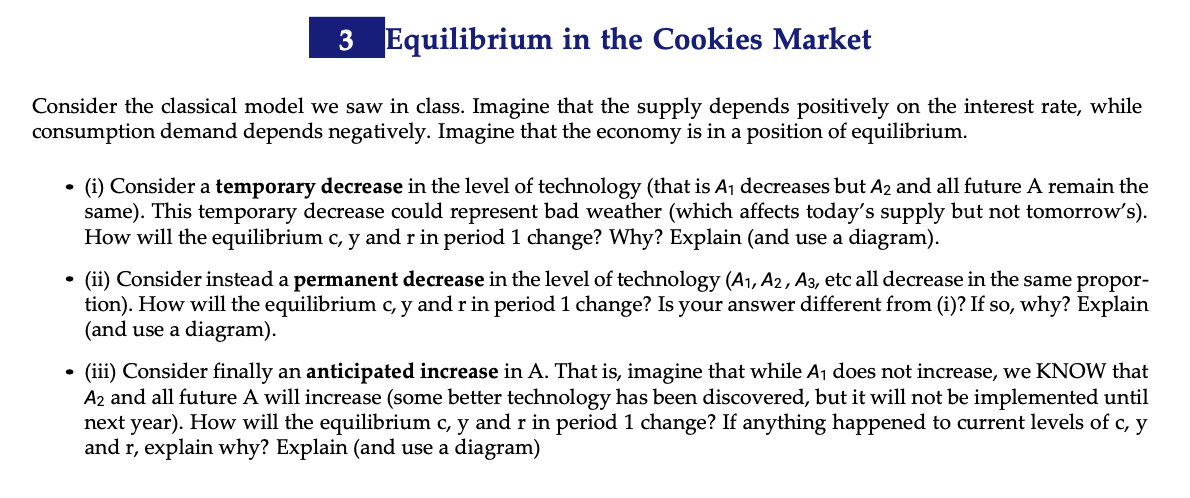3 Equilibrium in the Cookies Market Consider the classical model we saw in class. Imagine that the supply depends positively on the interest rate, while consumption demand depends negatively. Imagine that the economy is in a position of equilibrium. (i) Consider a temporary decrease in the level of technology (that is Aj decreases but A2 and all future A remain the same). This temporary decrease could represent bad weather (which affects today's supply but not tomorrow's). How will the equilibrium c, y and r in period 1 change? Why? Explain (and use a diagram). (ii) Consider instead a permanent decrease in the level of technology (A1, A2, A3, etc all decrease in the same propor- tion). How will the equilibrium c, y and r in period 1 change? Is your answer different from (i)? If so, why? Explain (and use a diagram). (iii) Consider finally an anticipated increase in A. That is, imagine that while Aj does not increase, we KNOW that A2 and all future A will increase (some better technology has been discovered, but it will not be implemented until next year). How will the equilibrium c, and r, explain why? Explain (and use a diagram) and r in period 1 change? If anything happened to current levels of c, y
3 Equilibrium in the Cookies Market Consider the classical model we saw in class. Imagine that the supply depends positively on the interest rate, while consumption demand depends negatively. Imagine that the economy is in a position of equilibrium. (i) Consider a temporary decrease in the level of technology (that is Aj decreases but A2 and all future A remain the same). This temporary decrease could represent bad weather (which affects today's supply but not tomorrow's). How will the equilibrium c, y and r in period 1 change? Why? Explain (and use a diagram). (ii) Consider instead a permanent decrease in the level of technology (A1, A2, A3, etc all decrease in the same propor- tion). How will the equilibrium c, y and r in period 1 change? Is your answer different from (i)? If so, why? Explain (and use a diagram). (iii) Consider finally an anticipated increase in A. That is, imagine that while Aj does not increase, we KNOW that A2 and all future A will increase (some better technology has been discovered, but it will not be implemented until next year). How will the equilibrium c, and r, explain why? Explain (and use a diagram) and r in period 1 change? If anything happened to current levels of c, y
Brief Principles of Macroeconomics (MindTap Course List)
8th Edition
ISBN:9781337091985
Author:N. Gregory Mankiw
Publisher:N. Gregory Mankiw
Chapter16: The Influence Of Monetary And Fiscal Policy On Aggregate Demand
Section: Chapter Questions
Problem 8PA
Related questions
Question
please answer (i)(ii)

Transcribed Image Text:3 Equilibrium in the Cookies Market
Consider the classical model we saw in class. Imagine that the supply depends positively on the interest rate, while
consumption demand depends negatively. Imagine that the economy is in a position of equilibrium.
(i) Consider a temporary decrease in the level of technology (that is Aj decreases but A2 and all future A remain the
same). This temporary decrease could represent bad weather (which affects today's supply but not tomorrow's).
How will the equilibrium c, y and r in period 1 change? Why? Explain (and use a diagram).
(ii) Consider instead a permanent decrease in the level of technology (A1, A2, A3, etc all decrease in the same propor-
tion). How will the equilibrium c, y and r in period 1 change? Is your answer different from (i)? If so, why? Explain
(and use a diagram).
(iii) Consider finally an anticipated increase in A. That is, imagine that while Aj does not increase, we KNOW that
A2 and all future A will increase (some better technology has been discovered, but it will not be implemented until
next year). How will the equilibrium c,
and r, explain why? Explain (and use a diagram)
and r in period 1 change? If anything happened to current levels of c, y
Expert Solution
Introduction
Before the Great Depression, the Classical Model was popular. It claims that the economy is very free-flowing and that prices and salaries respond easily to demand fluctuations over time. To put it another way, when things are good, wages and prices rise swiftly, and when times are bad, wages and prices fall easily.
Trending now
This is a popular solution!
Step by step
Solved in 2 steps

Knowledge Booster
Learn more about
Need a deep-dive on the concept behind this application? Look no further. Learn more about this topic, economics and related others by exploring similar questions and additional content below.Recommended textbooks for you

Brief Principles of Macroeconomics (MindTap Cours…
Economics
ISBN:
9781337091985
Author:
N. Gregory Mankiw
Publisher:
Cengage Learning

Essentials of Economics (MindTap Course List)
Economics
ISBN:
9781337091992
Author:
N. Gregory Mankiw
Publisher:
Cengage Learning

Principles of Economics (MindTap Course List)
Economics
ISBN:
9781305585126
Author:
N. Gregory Mankiw
Publisher:
Cengage Learning

Brief Principles of Macroeconomics (MindTap Cours…
Economics
ISBN:
9781337091985
Author:
N. Gregory Mankiw
Publisher:
Cengage Learning

Essentials of Economics (MindTap Course List)
Economics
ISBN:
9781337091992
Author:
N. Gregory Mankiw
Publisher:
Cengage Learning

Principles of Economics (MindTap Course List)
Economics
ISBN:
9781305585126
Author:
N. Gregory Mankiw
Publisher:
Cengage Learning

Principles of Macroeconomics (MindTap Course List)
Economics
ISBN:
9781305971509
Author:
N. Gregory Mankiw
Publisher:
Cengage Learning

Principles of Economics, 7th Edition (MindTap Cou…
Economics
ISBN:
9781285165875
Author:
N. Gregory Mankiw
Publisher:
Cengage Learning

Principles of Macroeconomics (MindTap Course List)
Economics
ISBN:
9781285165912
Author:
N. Gregory Mankiw
Publisher:
Cengage Learning